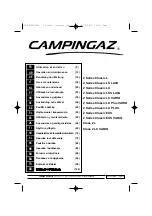
21
5.
Adjust the inlet pressure according to the gas type used. Refer to the equipment’s rating label
or the Gas Specification Table on page 5 of this manual.
6.
Turn ON the isolation gas valve, and open one burner and set at “High Flame”
7.
Check the pressure reading in the manometer. The manometer pressure reading should be
according to the pressure of the gas type used. Refer also to the Gas Specification Table on page
5 of this manual.
8.
Turn ON all the pilots and main burners and check the flame for any abnormalities.
9.
Check the connections for gas leak. Use any authorized gas leak detecting solution to check for
gas leak. Never use naked flame to check for gas leaks.
10.
Adjust the burner’s air shutter, as necessary, to eliminate yellow flame and lifting of flames, and
other burner flame abnormalities.
11.
Refit the pilot covers, radiants, cast grates, front panel cover, and knobs.
12.
After converting the unit, ensure to post the new label with the appropriate gas type used. Fill-
up the Gas Conversion Label and attach it to the unit beside the rating label.
13.
Before leaving the premises, ensure to check the functions of the following:
a.
Pilot burner ignition
b.
Pilot burner flame. It should stay lit.
c.
Main burners, “HIGH” flame and “LOW” flame.
d.
Check for gas leaks on the connections that were disturbed during the gas conversion.
CAUTION!
To avoid property damage, personal injury or death, all gas joints and connections disturbed
during servicing or gas conversion must be checked for gas leaks. Check with a soap and
water solution (bubble test), or any authorized gas detecting solution. Do not use naked
flame to check for gas leaks.
Summary of Contents for CF380-N
Page 30: ...30 VIII Exploded View Model DC331 N DC331 P ...
Page 31: ...31 Model CF380 N CF380 P ...
Page 34: ......
Page 35: ......
















































